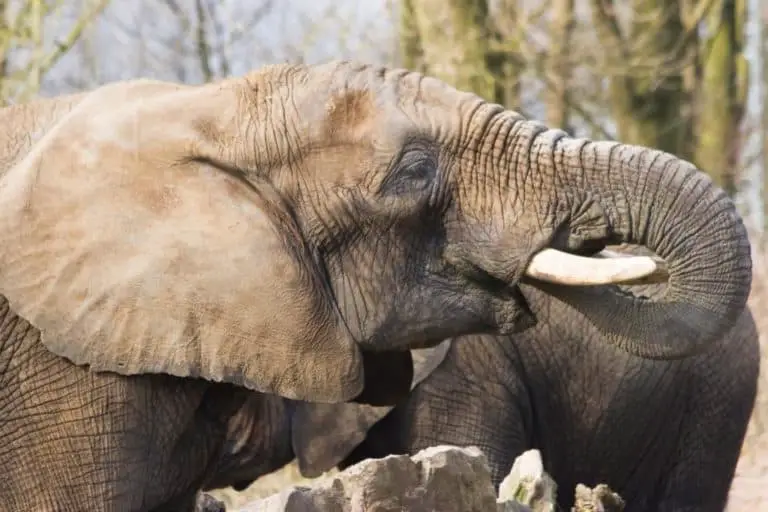22 Wild Animals You’ll Find in North America
North America is home to many wildlife, from the tiny hummingbird to the mighty grizzly bear. In between these extremes, countless other creatures call this continent home.
Here are a few of the most common animals you might encounter on a North American expedition.
1) Bald Eagle

The bald eagle is one of America’s most stunning and iconic birds. Something about that stark white head and tail feathers against its dark body makes it so easy to spot and recognize.
And while these magnificent creatures are mostly found near large bodies of water, like lakes, rivers, and oceans – they’re also known to make their homes in wooded areas from time to time.
Perhaps what they’re most known for, however, is their skill as hunters. These incredible birds of prey are more than capable of taking down animals as large as deer with ease.
In addition to hunting skills, bald eagles are highly respected for their aerial abilities. They can fly at high speeds and efficiently perform intricate maneuvers, making them a popular choice for bird shows and demonstrations across the country.
It’s worth noting that bald eagles were once on the brink of extinction but have made a strong comeback in recent years and are now a protected species.
- Family: Accipitridae
- Lifespan: 20 – 30 Years
- Weight: Female 10 to 15 lbs / Males 6 to 9 lbs.
- Length: 36 inches on average.
- Wingspan: 6.5 feet
- Speed: 100 mph
2) Jaguar

The jaguar is a large cat unique to the Americas among the Panthera species.
The jaguar’s present range encompasses the western United States and Mexico through Central America and South America, east of the Andes, and north of the Amazon River.
Although single cats may be found in the Western United States today, the species has been largely eliminated from the United States since 1960. It roamed Nevada, Utah, Arizona, New Mexico, and Texas.
Jaguars are nocturnal hunters who prey on deer, pigs, hares, sloths, and monkeys though they may occasionally eat larger prey. They are powerful, agile, and can take down targets much more significant than themselves.
One of their favorite targets is the irrigation water buffalo, weighing up to 2,000 pounds. Jaguars will stalk their prey before leaping onto its back and delivering a fatal bite to the skull.
They will also take smaller prey, such as rodents, if available. Jaguars are apex predators, which means they have no natural enemies. As a result, they play an essential role in balancing the ecosystem.
- Family: Felidae
- Lifespan: 12 – 15 Years
- Weight: Male from 126 to 250 lbs / Female from 100 to 200 lbs
- Length: 5.6 to 9 feet
- Speed: 50 miles per hour
3) American Bison
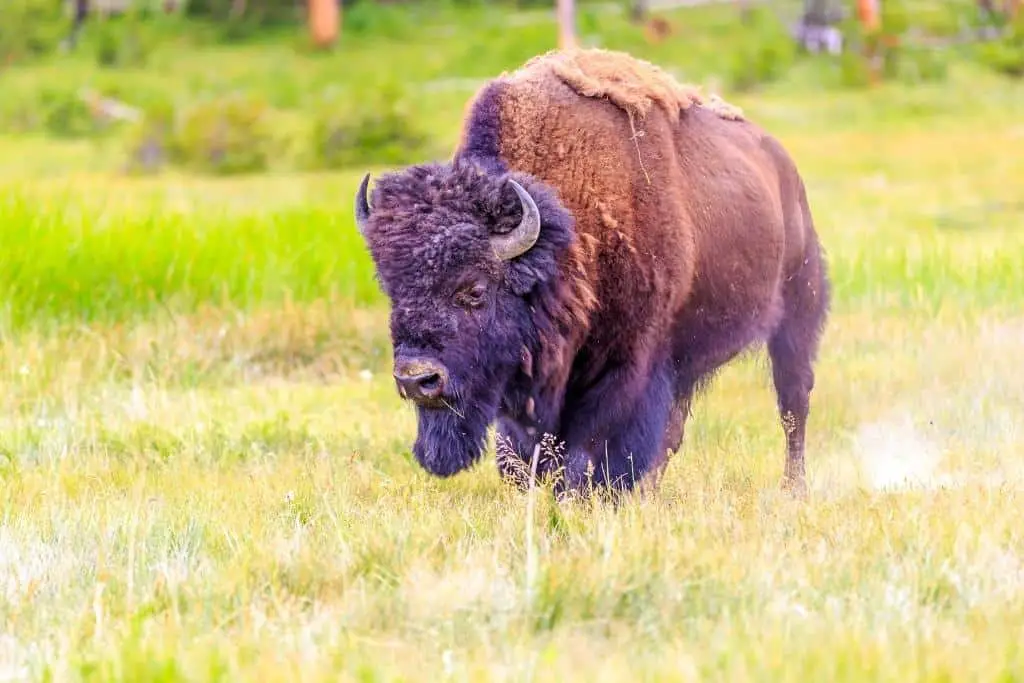
The American Bison is an impressive animal. It’s massive, with males averaging around 2,000 pounds. And it has a shaggy coat, typically brown or dark chestnut.
But the Bison’s most distinctive feature is its head. It’s large and heavy, with short, curved horns.
The male Bison also has a long hair beard hanging down from its chin. Bison are social animals and live in herds of a few dozen to several thousand individuals.
These herds typically graze on grasses and other plants, occasionally eating leaves and twigs.
During winter, Bison often dig through snow to reach the grass beneath. The American Bison once roamed across North America in huge numbers, but their population was significantly reduced during the 19th century due to overhunting.
Several thousand Bison live in North America, mostly in parks and reserves. So if you ever have a chance to see one in person, don’t miss it! They’re imposing animals.
- Family: Bovidae
- Lifespan: 10 – 20 Years
- Weight: Male 2,000 lbs / Female from 1,000 lbs
- Length: Males feet 6; Females 4/5 feet
- Speed: 35 miles per hour
4) Arizona Bark Scorpions
Scorpions are nocturnal hunters that prey on a variety of tiny creatures, including insects, spiders, and other scorpions. Arizona bark scorpions are one of the most venomous species of scorpion in North America, and their venom can be dangerous to humans.
However, these creatures are not aggressive and will only sting humans if they feel threatened. Scorpions are shy animals that prefer to avoid contact with people.
In fact, many people who are stung by scorpions are actually trying to kill the creature. If you come into contact with a scorpion, it is essential to remain calm and avoid panicking.
Getting stung by a scorpion is painful, but it is not usually life-threatening. With proper medical treatment, most people make a full recovery.
- Family: Buthidae
- Venom or Poison: Most venomous scorpion in North America
- Lifespan: 5 – 7 Years
- Weight: Two ounces
- Length: 2.5 inches
5) Eastern Moose
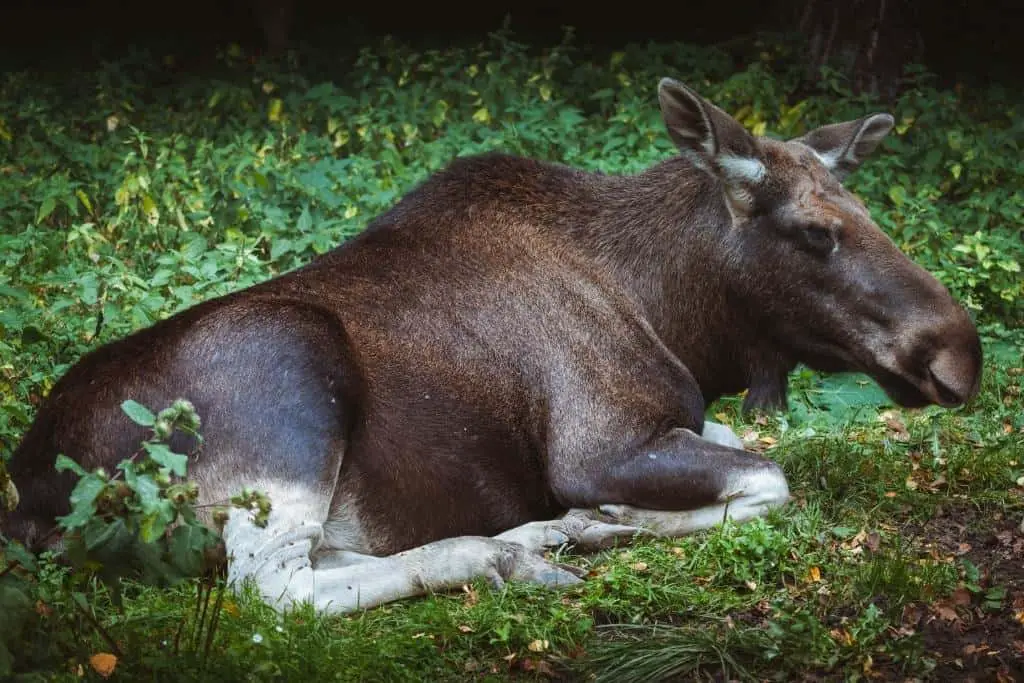
The Eastern Moose is the most prominent member of the deer family. You can find them in woods across Canada and the northeastern United States. Male moose can grow up to six feet tall at the shoulder and weigh up to 1,400 pounds. That’s big! Female moose are more minor, typically standing five feet tall at the shoulder and weighing up to 800 pounds.
- The Eastern Moose has long legs and a large, bulbous nose.
- Their coat is thick and dark brown in color.
Moose are primarily herbivorous, grazing on leaves, twigs, and bark. In winter, when food is scarce, they will also eat mosses and lichens. Moose are solitary animals and do not form herds. During the summer months, bulls will roam in search of cows to mate with. In the spring, a cow will birth to one or two calves. The young moose stay with their mother for about a year before departing.
- Family: Cervidae
- Lifespan: 10 – 12 Years
- Weight: Male 1,400 lbs / Female from 800 lbs
- Length: Males 5.6 to 6.6 feet; Females 5.6 feet on average.
- Speed: 35 miles per hour
6) North American Beavers
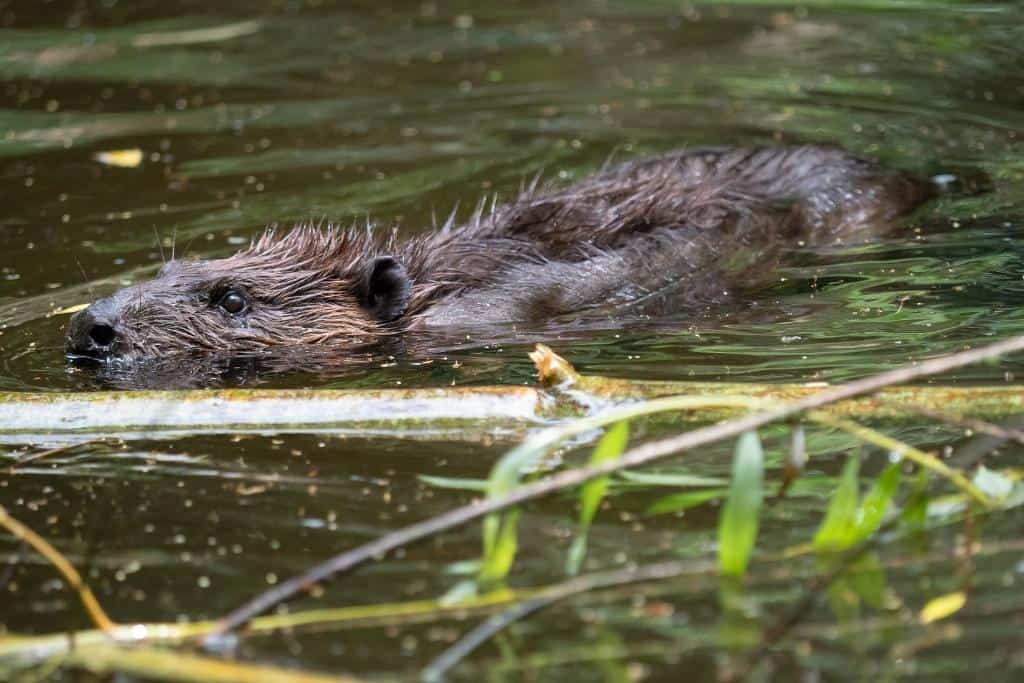
North American beavers are large, semi-aquatic rodents known for their ability to fall trees and build dams. They are native to North America and inhabit many habitats, including forests, wetlands, and rivers.
Beavers are the most significant type of rodents in North America, and they can grow up to four feet long and weigh over 70 pounds. Their big, furry tails are used for steering when swimming and for balancing when standing on their hind legs.
Beavers have webbed feet and waterproof fur that help keep them warm in the cold water; they are primarily nocturnal animals but can sometimes be seen active during the day.
They build their homes, called lodges, out of sticks and mud with an underwater entrance leading to a dry chamber where they can rest and escape predators.
North American beavers play an essential role in their ecosystems; their dams help to reduce erosion and create new habitats for other animals. If you’re lucky enough to spot one of these creatures in the wild, it’s sure to be a memorable experience.
- Family: Castoridae
- Lifespan: 20 Years
- Weight: 40 to 70 pounds
- Length: two to three feet
- Speed: 2 to 6 mph
7) American Alligator
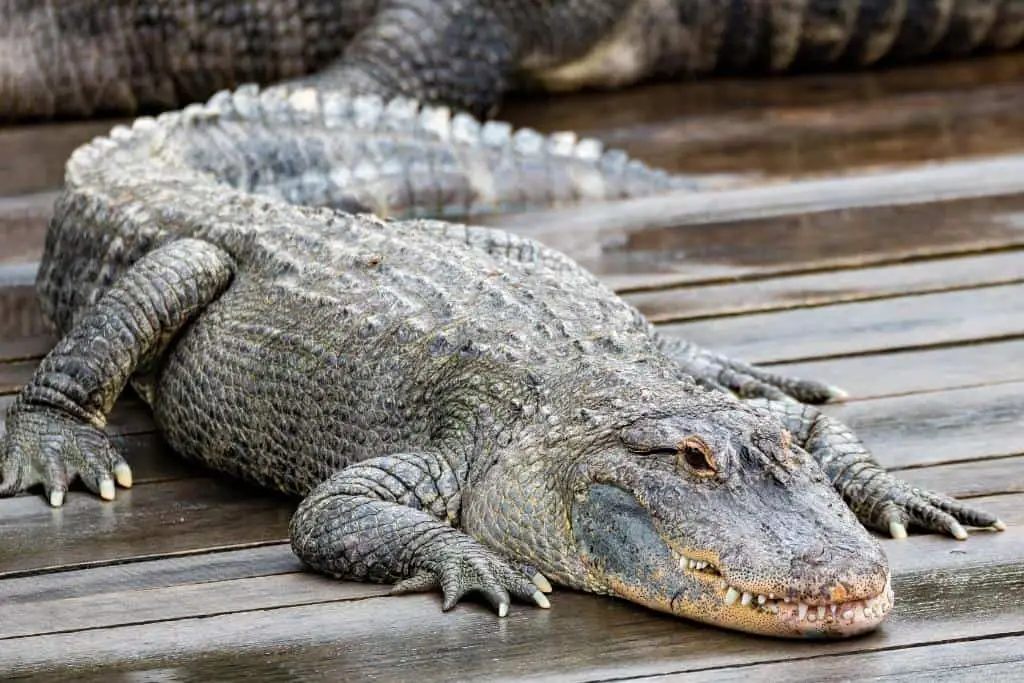
The American Alligator is a giant reptile found in the southeastern United States. Adult alligators can grow up to 15 feet in length and weigh over 600 pounds.
Although they are generally shy around humans, alligators can be aggressive if they feel threatened. They are good swimmers and capable of short bursts of speed on land. Alligators prefer to live near water, where they can hunt for fish, frogs, and other small animals.
During the day, they bask in the sun on the banks of lakes and rivers. They retreat into the water at night to avoid predators such as bears and coyotes.
Alligators are one of the few species able to adapt to saltwater and freshwater environments. They play an essential role in the ecosystems of the southeastern United States and are an important part of American wildlife.
- Family: Alligatoridae
- Lifespan: 30 – 50 Years
- Weight: 500 to 600 pounds on average.
- Length: 11 to 15 feet on average.
- Speed: 35 miles per hour on land. 20 mph on water.
8) Raccoons
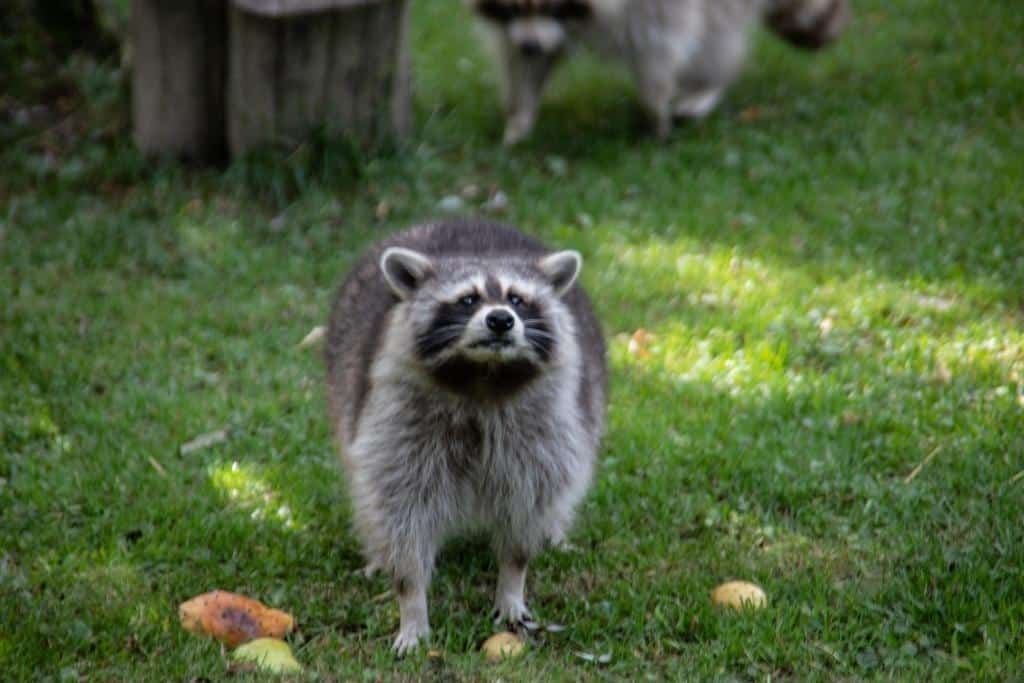
Raccoons are fascinating creatures. Thanks to their distinctive masks, they’re easily recognizable, and they’re also brilliant. They’re one of the few animals that can solve puzzles and excellent climbers.
They can climb straight up a tree trunk or an overhead power line. A raccoon can descend a tree headfirst without any difficulty.
Raccoons are also excellent swimmers. They have webbed feet and long, sharp claws that help them quickly move through the water. And they’re not afraid to get their food wet; they’ll dive into a stream to catch fish or swim in the ocean to catch crabs.
- Family: Bovidae
- Lifespan: 2 – 3 Years
- Weight: 11 to 57 lb
- Length: 16 to 28 in
- Speed: 16 to 24 miles per hour
9) Mountain Lion
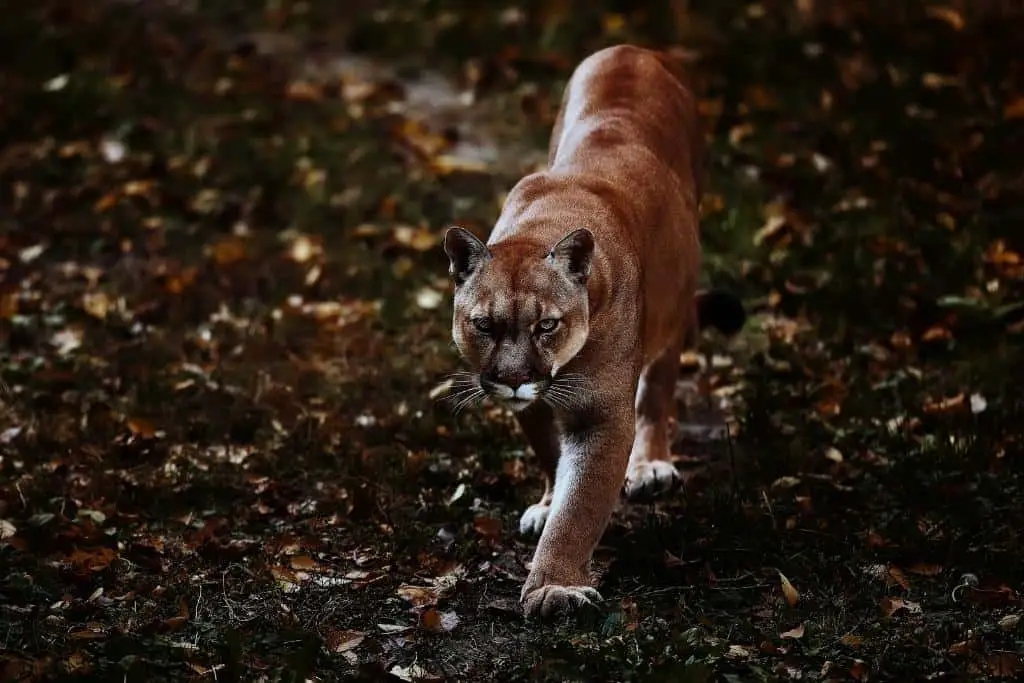
The mountain lion is a large and powerful animal known to attack humans. Although they are not usually aggressive, they can be dangerous if they feel threatened. Mountain lions are native to the Americas, extending from Canada to South America.
They are adaptable animals that can live in different types of habitats. Mountain lions are ambush predators, using their camouflage and terrain to remain hidden until they are close enough to strike. When they attack, they try to break the animal’s neck or suffocate it by biting its throat.
The cat drags its kill to a hiding place where it feeds undisturbed.
The cougar is a solitary animal that, by nature, is considered nocturnal and crepuscular, although daytime sightings do happen.
- Family: Felidae
- Lifespan: 8 – 13 Years
- Weight: 135 – 175 pounds
- Length: 8 feet on average.
- Speed: Up to 50 miles per hour
10) Brown Bear
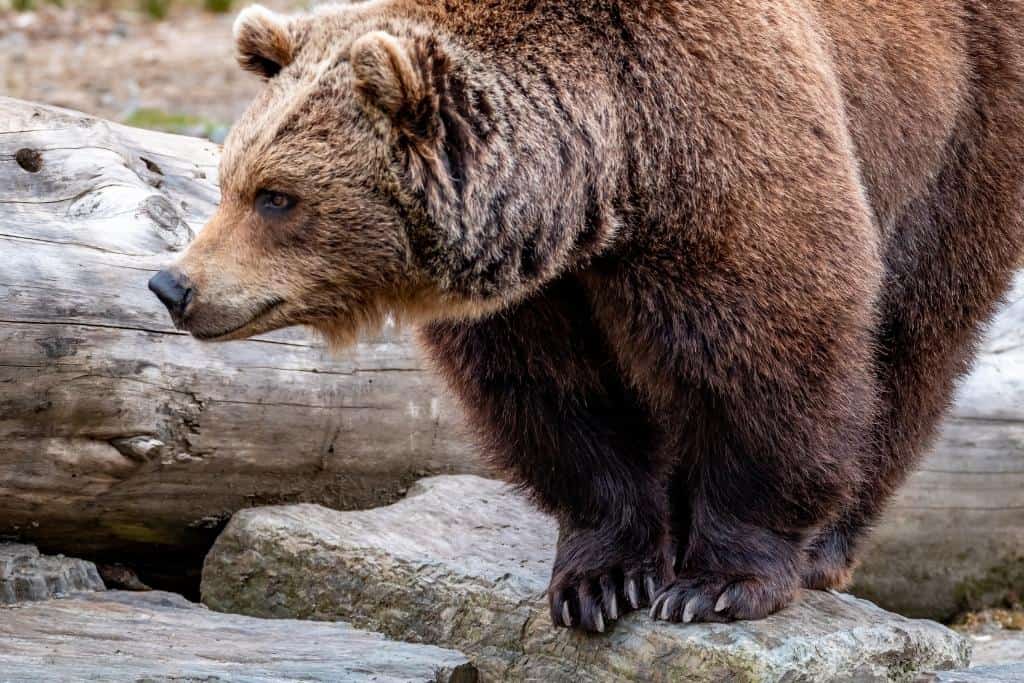
The brown bear is a large mammal found in forests across the Northern Hemisphere.
Brown bears are typically larger than other bears, with males weighing up to 800 lbs. They have shaggy fur ranging from light brown to black, and their diets consist primarily of plants and fruits.
However, they are also known to eat fish, small mammals, and carrion.
Brown bears are found in North America, Europe, and Asia and are considered a threatened species in some parts of their range.
Although they are primarily solitary creatures, brown bears sometimes gather in groups to feed or mate. They are also one of the few animals known to attack humans.
In most cases, these attacks are defensive and occur when a bear feels threatened or startled.
However, brown bears can be dangerous predators, and it is essential to be aware of their presence when hiking or camping in areas where they live.
- Family: Ursidae
- Lifespan: 20 – 30 Years
- Weight: Male 300 to 860 pounds / Female 205 to 455 pounds
- Length: 5-7 feet. Hight: 3-5 feet.
- Speed: 35 miles per hour.
11) Bighorn sheep
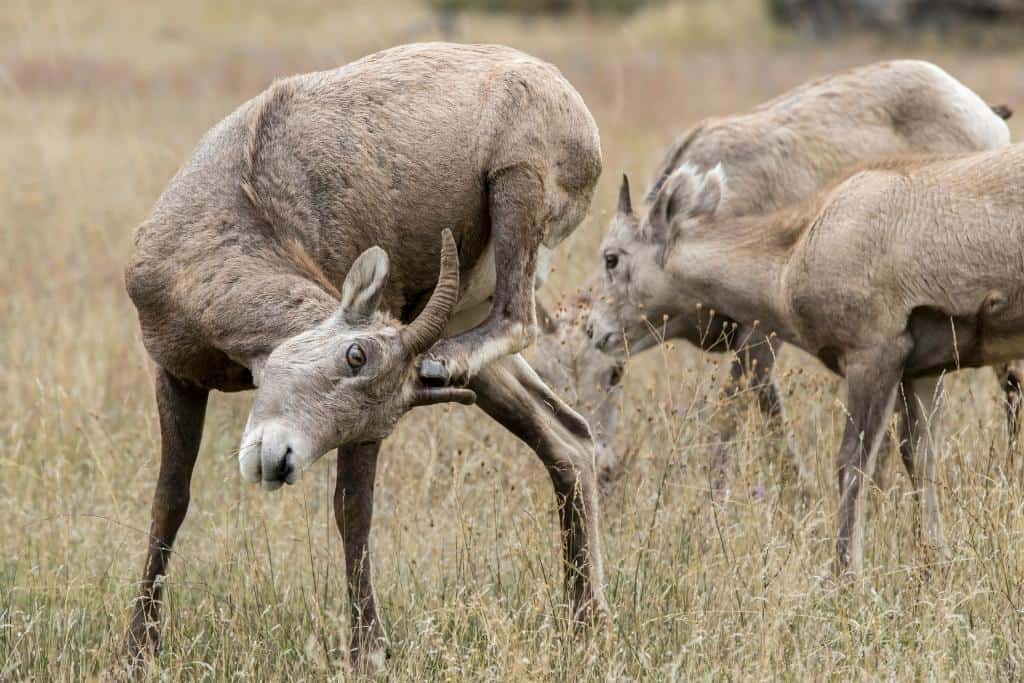
Bighorn sheep are a species of wild sheep indigenous to North America. The name “bighorn” comes from these animals’ large horns. Male bighorn sheep have more giant horns than females, which they use to butt heads in disputes over mating rights.
Bighorn sheep are well adapted to high-altitude environments. They have curved and hard hooves, which help them grip the rocks and climb steep slopes. They also have a thick coat of fur that helps to keep them warm in cold weather.
Bighorn sheep are herbivores whose diet consists mainly of grasses and shrubs. These animals are essential for their ecosystems’ health because they help spread plant life by eating and passing seeds through their digestive system.
Bighorn sheep play an essential role in maintaining the balance of their ecosystems and are a keystone species for the health of North American landscapes.
- Family: Bovidae
- Lifespan: 10 – 15 Years
- Weight: 262 to 280 lbs
- Length: 5 to 6 feet
- Speed: 20 miles per hour
12) Groundhog / Woodchuck

The groundhog, also known as the woodchuck, is a rodent of the family Sciuridae, belonging to the giant ground squirrels known as marmots. The groundhog is well adapted to its terrestrial environment.
It is a burrowing animal with short, powerful legs and long front claws for digging.
The adult groundhog is usually 16″ -20″ in length from nose to tail, with a body mass of around 13 lbs.
Groundhogs are found in North America, from southern Canada to northern Georgia in the United States.
They have also been introduced to parts of Europe, such as Germany and Switzerland. Groundhogs are generally considered pests due to burrowing into gardens and Playboy golf courses.
- Family: Sciuridae
- Lifespan: Up 14 years
- Weight: 13 pounds on average.
- Length: 16″ -20″
- Speed: 1.86 mph; they can reach 10 mph.
13) Atlantic horseshoe crab / American horseshoe crab
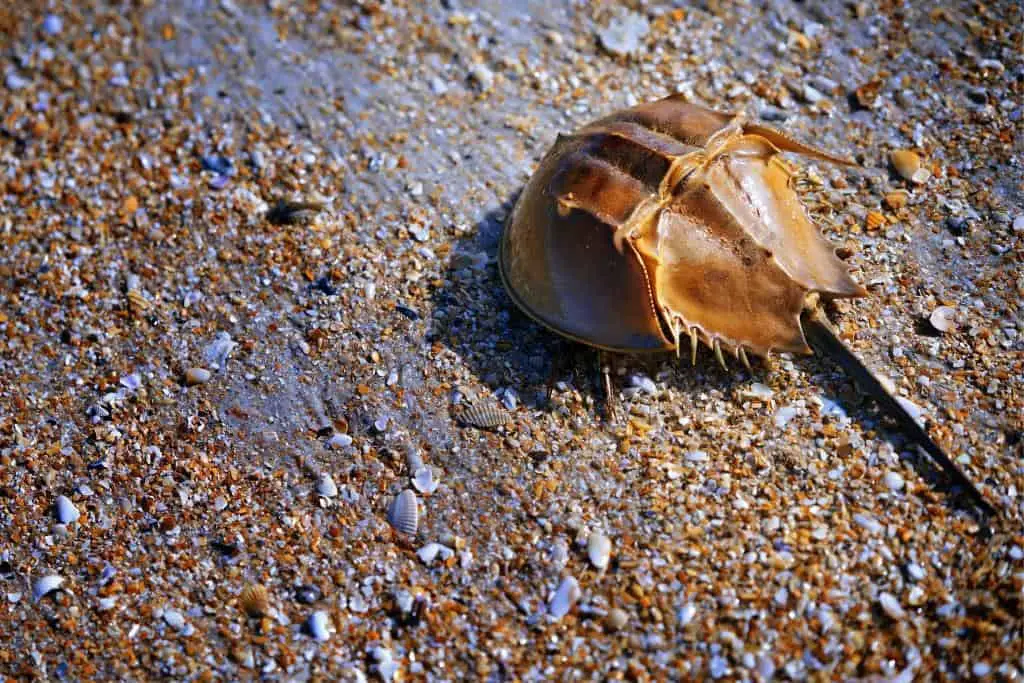
The American horseshoe crab is a crab found on the East Coast of the United States. These crabs are exciting creatures, and they have a long history.
Horseshoe crabs are thought to have first appeared on Earth over 450 million years ago, making them one of the oldest animal groups still in existence today. These crustaceans get their name from their shape, which resembles a horseshoe.
American horseshoe crabs are dark brown or black in color and can grow to be about 15 inches long.
Horseshoe crabs are scavengers and play an essential role in the ecosystem by helping clean up beaches and other areas.
These animals are also crucial to the medical field, as their blood tests for bacteria in medicines and vaccines.
- Family: Limulidae
- Lifespan: 10 Years
- Weight: 2.2 to 9.9 pounds
- Length: Males 14 to 15 in; Females 8 – 19 in
14) Canada Goose

The Canada goose is a large wild goose with a black head and neck, white patches on the face, and a brown body. Native to North America’s arctic and temperate regions, it has been introduced to the United Kingdom, Ireland, New Zealand, Australia, Chile, and Argentina. Some consider Canada Geese a nuisance because of their noise and droppings, but they are also recognized for their role in controlling weed growth and dispersing seeds.
The Canada Goose is a famous bird for watching and hunting. It is also the national bird of Canada.
Fun Facts:
- The average lifespan of a Canada Goose is 10 – 24 years.
- Canada Geese mate for life.
- During migration, Canada Geese can fly up to 1,500 miles daily!
- Family: Bovidae
- Lifespan: 10 – 24 years
- Weight: Male 8 – 14 pounds / Female 7 – 12 pounds
- Wings Span: 50–73 in
- Speed: 40 miles per hour
15) Coyotes
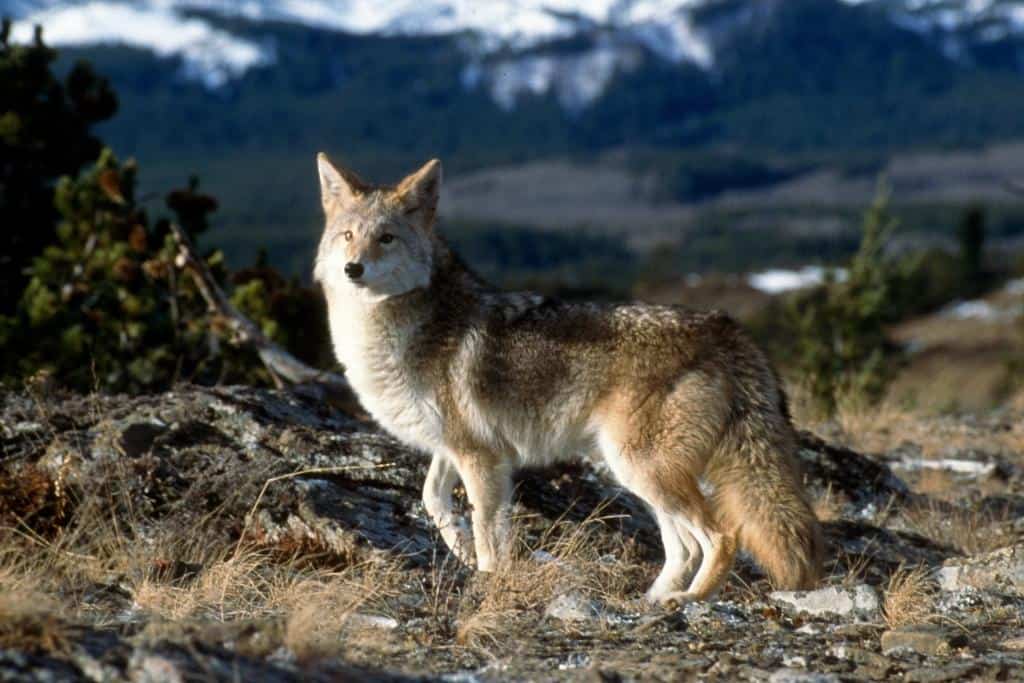
Coyotes are a type of canine native to North and Central America. Though they’re smaller than wolves, they’re larger than foxes. With pointy ears, a bushy tail, and long legs, coyotes are predators whose diets consist mainly of small mammals, such as rabbits and rodents. They’ll also eat birds, reptiles, and insects.
In recent years, coyotes have begun moving into urban areas for food. This has caused concern among some people who believe that coyotes may pose a threat to humans. However, coyotes are generally afraid of humans and will only attack if they feel threatened.
- Family: Canidae
- Lifespan: 10 – 14 Years
- Weight: 20 to 50 pounds
- Length: 3.3 to 4.3 feet
- Speed: 43 miles per hour
16) Hellbender
The Hellbender is a massive amphibian that can grow up to 2.5 feet in length. These strange-looking creatures are actually salamanders, and they are the most prominent members of their family in North America.
Hellbenders are endemic to the eastern United States and can be found in streams and rivers from New York to northern Georgia. Although they are Fully aquatic, hellbenders spend most of their time hiding under rocks at the bottom of waterways.
These shy animals are nocturnal and come out to hunt for food at night. Hellbenders feed on crayfish, fish, and other small aquatic creatures.
Due to their unique appearance, hellbenders have been the subject of many legends and superstitions.
In some Native American cultures, hellbenders were believed to be water monsters that could kill people with their toxic breath. However, these creatures are harmless to humans, and they play an essential role in maintaining the health of aquatic ecosystems.
- Family: Cryptobranchidae
- Lifespan: 30 Years
- Weight: 3.3 to 5.5 pounds
- Speed: 35 miles per hour
17) Gila Monster
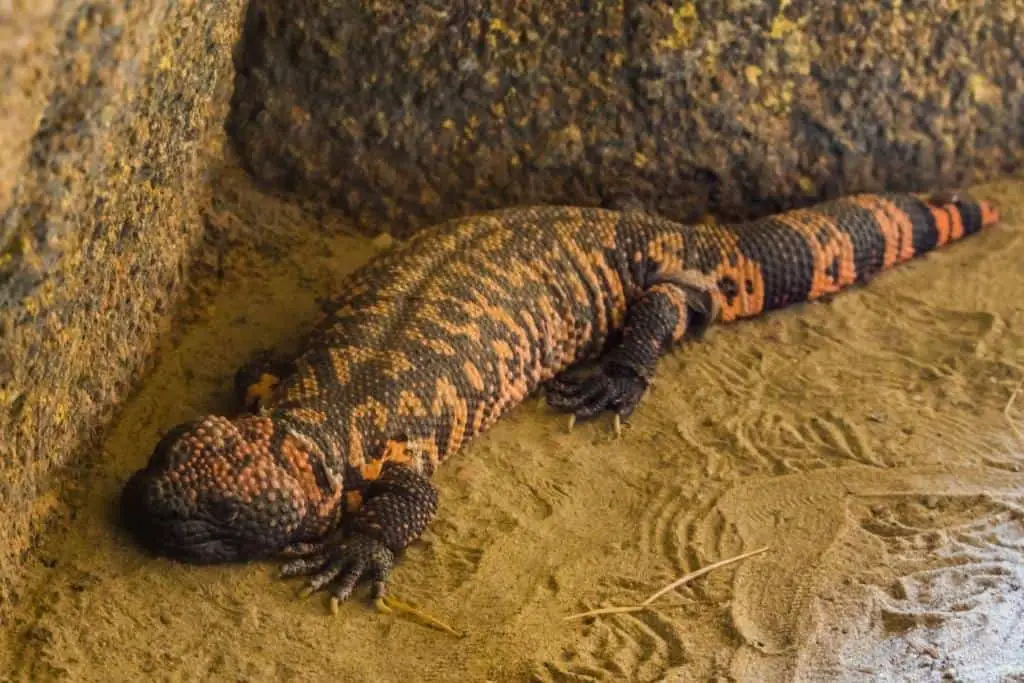
The Gila Monster is a giant, venomous lizard found in the southwestern United States and northern Mexico. These unique creatures are the only family members and the most giant lizards in North America.
Gila Monsters are easily recognizable, thanks to their bright colors and patterns. They are typically black with orange or yellow spots and have a pink or orange belly.
Gila Monsters grow to an average length of two feet and can weigh up to five pounds. Despite their size, these lizards are quite shy and reclusive, preferring to spend most of their time hiding in burrows or under rocks.
Gila Monsters only come out to bask in the sun or to hunt for food. When they do hunt, they use their long tongues to smell out their prey before striking with lightning speed.
Thanks to their venomous bite, Gila Monsters can kill animals as large as rabbits. Fortunately for humans, these lizards are not aggressive towards people and rarely bite unless they feel threatened.
- Family: Helodermatidae
- Lifespan: 20 – 36 Years
- Weight: 3-5 lbs
- Length: 18 to 22.5 inches
- Venom or Poison: Yes
18) Bobcat

The bobcat is a North American cat belonging to the Felidae family. You can find them in various habitats, including wooded, semi-desert, and urban areas.
They even inhabit forest edges and swampland environments. With twelve distinct subspecies, they are found all over the continental United States.
Despite varying locations, all these habitats have in common: the bobcat can adapt and thrive in them. The bobcat has maintained a healthy population throughout its original range, thanks to its adaptability.
Bobcats have short fur, typically brown or grey, with dark spots on their body and black tufts on their tail.
While their skin provides excellent camouflage in their natural habitat, bobcats are not shy about approaching humans and have even been known to turn up in people’s backyards!
Although they are generally shy around people, bobcats are fierce predators and will hunt anything from rabbits to deer.
- Family: Felidae
- Nickname: Wildcats
- Lifespan: 7 Years
- Weight: 21 lb on average.
- Length: 30-50 inches long.
- Speed: 30 miles per hour
19) (American) Bullfrog

The American bullfrog, also known as the northern leopard frog, is a giant frog found throughout much of North America. They are most commonly found near permanent bodies of water, such as lakes, ponds, and rivers.
Adult American bullfrogs can grow to be over 8 inches long and weigh over a pound. They are green or brown in coloration with dark spots on their body and legs.
Bullfrogs get their name from the loud “rumble” call that males make to attract mates and ward off other males.
These frogs are carnivores and eat almost any animal they can fit into their mouth, including rodents, snakes, birds, and other frogs.
Bullfrogs have been introduced to many parts outside their natural range, often with negative consequences for local ecosystems. In some areas, they are considered invasive species.
- Family: Ranidae
- Lifespan: 7 – 10 Years
- Weight: 1.5 pounds
- Length: 8 inches or more
- Venom or Poison: Yes
20) Elks
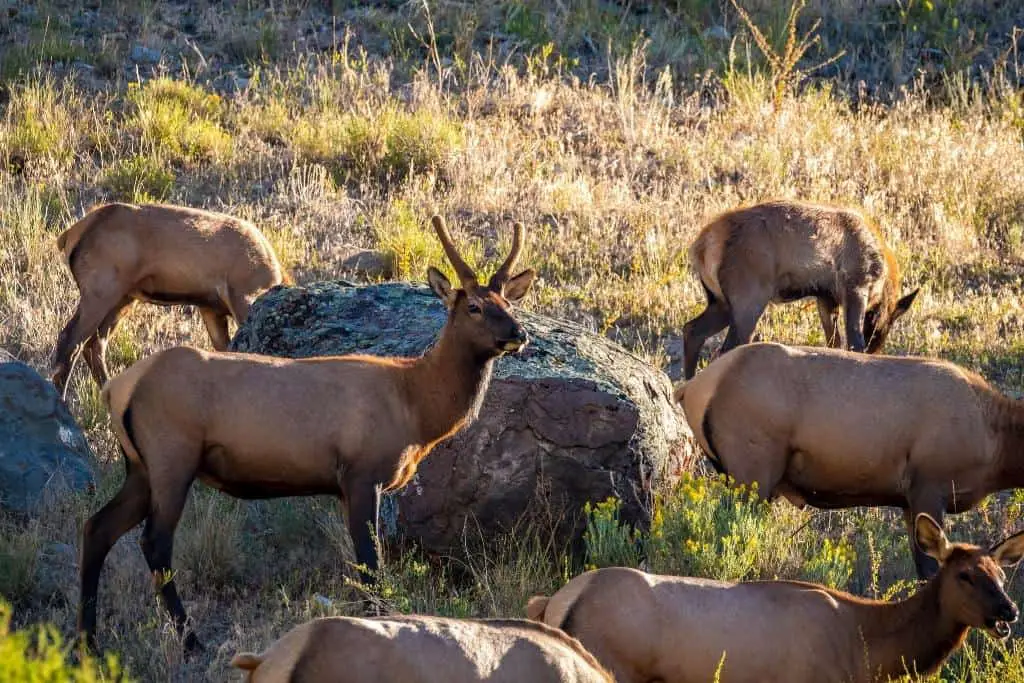
Elks are large mammals of the deer family. They are characterized by their long, curved antlers and their broad, hoofed feet. Elks are found across North America and Europe and have been introduced to New Zealand and Australia.
Elks are herbivores, and they browse a variety of plants. They are also known to eat small mammals, birds, and reptiles. In the wild, elks typically live for 10-20 years.
Elks are active during the day and night. During the day, they rest in forested areas or in meadows. At night, they move about in search of food.
Elks are social animals and live in herds of 100 individuals. The size of a pack depends on the availability of food and water. Although elks are not typically aggressive animals, bulls can become violent during mating.
- Family: Cervidae
- Lifespan: 10/20 Years
- Weight: Cow 450 pounds, bull 800 pounds
- Length: 4.5-5 feet
- Speed: 45 miles per hour
21) Alligator Snapping Turtle
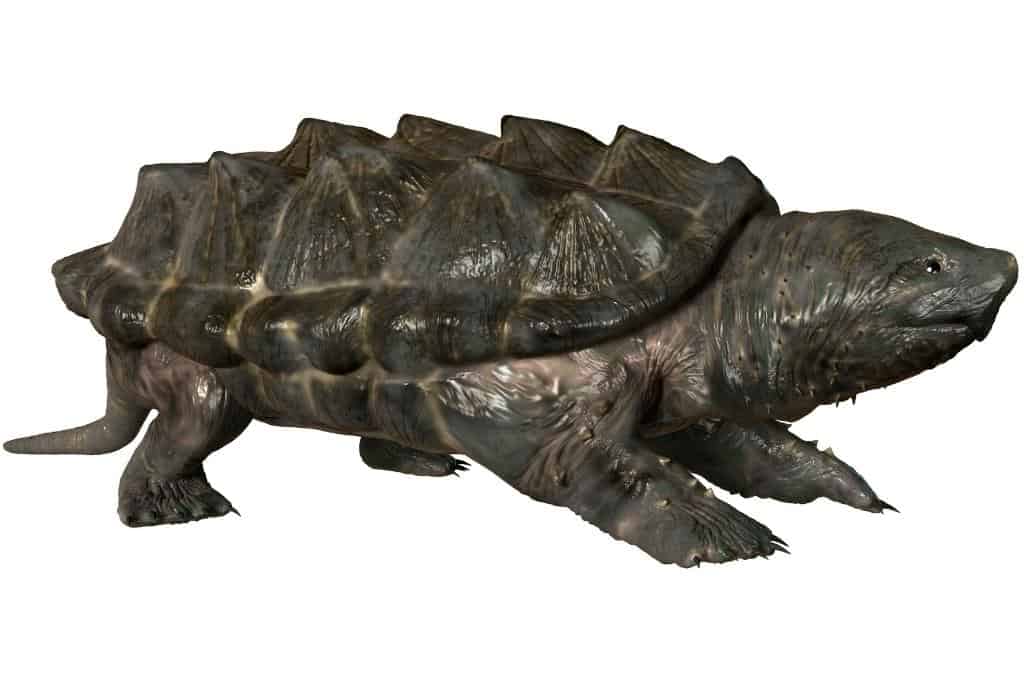
The alligator snapping turtle is one of the giant freshwater turtles in the world, with adults reaching lengths of up to three feet and weighing over 250 pounds.
These turtles get their name from their large size and powerful jaws, which can easily crush the shell of their prey.
Alligator snapping turtles are found in the southeastern United States, where they inhabit rivers, lakes, and swamps. These turtles are carnivores, and their diet consists primarily of fish, snails, and other small aquatic animals.
Alligator snapping turtles are not considered endangered, but they are listed as a species of concern due to habitat loss and over-collection for the pet trade. These turtles are shy and reclusive by nature, but they are fascinating animals that deserve our protection.
- Family: Chelydridae
- Lifespan: 10/20 Years
- Weight: 249 pounds
- Length: 29 inches
- Bite force: 1,000 pounds
22) Chipmunk (Eastern)
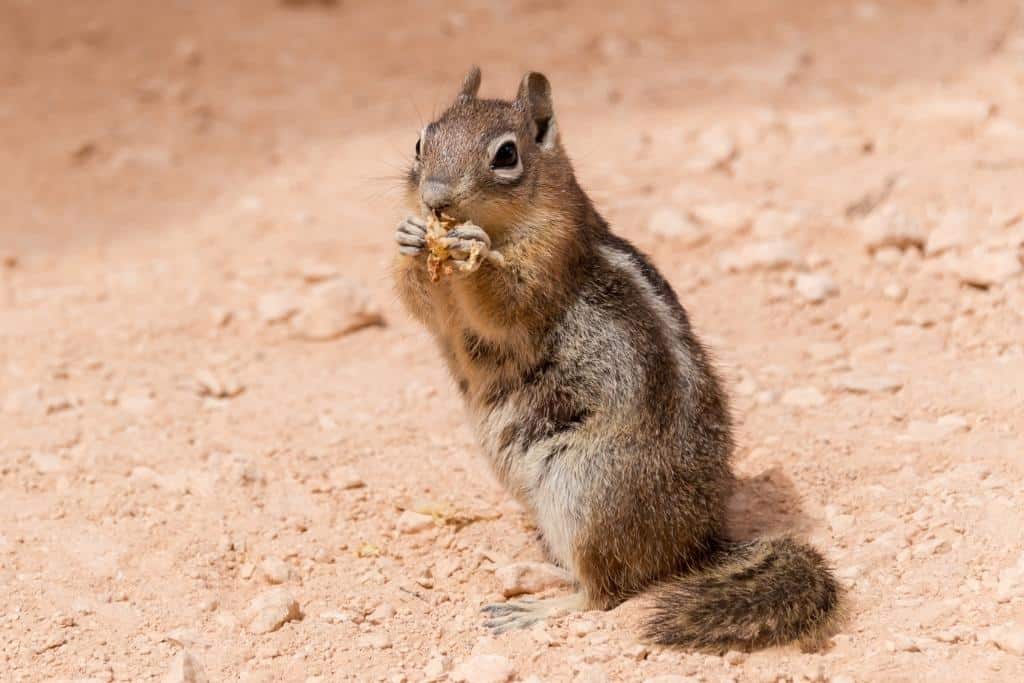
The eastern chipmunk is a small, striped squirrel found throughout the eastern United States and Canada. These shy animals are most active in the early morning and late afternoon, when they can be seen foraging for nuts and seeds.
Chipmunks spend much of their time in trees, building nests of leaves and twigs. In the winter, they hibernate in underground burrows.
Although they are generally solitary creatures, eastern chipmunks will sometimes join together in groups to mate or to share food. These playful animals are a common sight in many backyards, and their cheerful chirping often brings a touch of charm to the landscape.
- Family: Sciuridae
- Lifespan: 3 Years
- Length: Biggest: 11 inches. Smallest: 1.1 ounces
- Speed: 21 miles per hour
